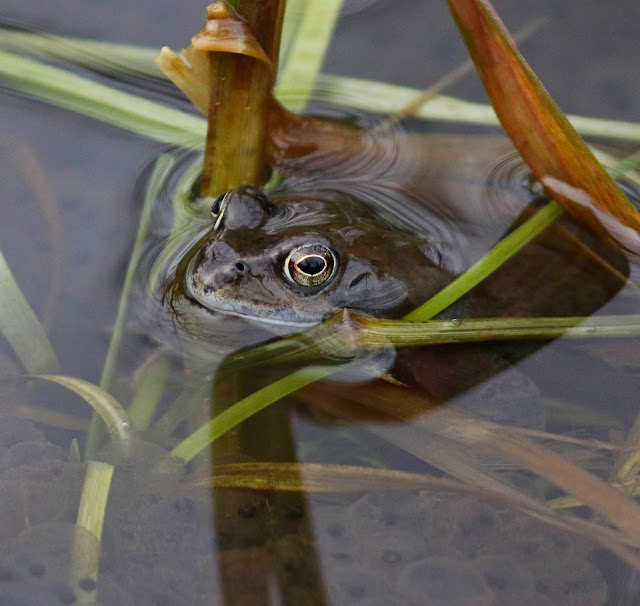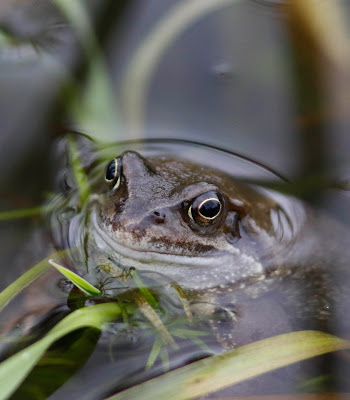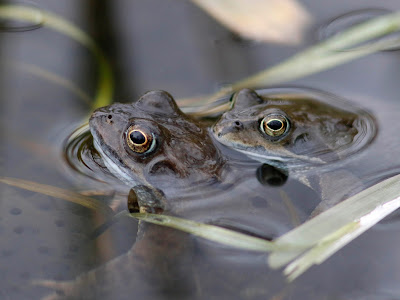 |
| c Mark Pidgeon |
Tuesday, 30 March 2021
A Sandwich at Farmoor 28th March 2021
Friday, 26 March 2021
Plover Perfection at Farmoor 24th March 2021
I went back to Farmoor early today, in the hope the three Black necked Grebes would have prolonged their stay but I was out of luck.They had gone, which was hardly surprising as the last I saw of them yesterday was as they were trying, with little success, to find an area on the reservoir that was not being encroached on by the sailing dinghys.
It was not all disappointment as I had managed to inadvertently flush two Grey Partridges first thing, from a field just outside the reservoir proper. These were very much a patch mega so the day had got off to a more than reasonable start. On finding there was a distinct lack of grebes, I wandered along the central causeway to discover a Dunlin, still in complete winter plumage, pottering along quietly at the water's edge.
What could it be? Was it the Dunlin? Moving closer an involuntary cheer rose to my lips as I set eyes upon the agreeable form of a Little Ringed Plover, something I had been planning to go and see elsewhere but here was one right in front of me, newly arrived and living confirmation of the onset of Spring migration. Like many of its kind it was relatively confiding and allowed me to approach reasonably closely without taking alarm.
As evidenced by the strong black banding on its head and breast I decided it was a male and on closer inspection I could see it still retained a vestige of brown winter plumage both within the black behind its eye and in the black breast band. They do not possess quite the chunkiness and robustness of their larger cousin the Ringed Plover. Everything about them is of a more delicate nature, the bill narrow, fine and black, the body attenuated and slimmer, the tail a fraction longer. Other aspects too identified it as a Little Ringed Plover, the bold, yellow orbital ring around each eye and the lack of white wing bars were both additional and conclusive pointers to its identity.
Little Ringed Plovers are one of the earliest Spring migrants to arrive on our shores, their wintering areas extending as far south as tropical Africa.They do not undertake quite the phenomenal migrations of their larger cousin, which covers vast distances to reach both wintering and breeding grounds. Nor do they show the Ringed Plover's preference for breeeding on coastal shingle, sandy beaches and strands but nest inland in freshwater habitats on areas of vegetation free sand and pebbles, often in active gravel pits, reservoirs or old quarries. The first pair to colonise Britain bred in a newly excavated gravel pit at Tring, Hertfordshire, in 1938 and with no shortage of new gravel pits being excavated in subsequent years their population has spread and increased until there are now up to 1300 pairs breeding from southern England to northeast Scotland.
Little Ringed Plovers used to breed at Farmoor, more years ago than I care to remember. I can recall sitting in the hide at Pinkhill and looking out when all I could see was a series of bare gravel islands and watching a pair tending their newly hatched young. Oh how I wish it were still so but the tiny reserve was left to its own devices with the result that vegetation and reeds took over, the habitat became unsuitable and the LRP's left, never to return.
I watched the diminutive plover running along the edge of the concrete, its fawn upperbody plumage making it nigh on invisible against the bleached concrete. It paused in its plovery way, then stooped to seize something and running a few steps more, then stood quietly. The sun came out and its slim body took on a more rounded appearance as it relaxed. Seconds later it sank down on folded legs to sit in the sun with eyes beginning to close, the embodiment of content.
It could not last long. The area it favoured was also needed to launch the boats and soon the inevitable disturbance became too much to bear and it fled, leaving me with that familiar warm glow of achievement on discovering an unusual wild bird.
Tuesday, 23 March 2021
A Fabulous Find at Farmoor 23rd March 2021
After days of cold northwesterly winds, strong enough to cause mild discomfort, the wind swung to the southwest overnight and as day follows night so the reservoir welcomed a smattering of summer migrants. Not too many mind - this is Farmoor after all and we do not want to get ahead of ourselves.
Chiffchaffs have been singing along the Thames Path these past days but only when the sun is shining. Up to four of them. Ornithological metronomes, they seesaw a two note song endlessly, from high in the bare trees. A simple signal of the Spring returning, bringing annual hope and renewal. The feral Greylags are pairing up now, each pair seeking privacy from their fellow geese, scattering to separate territories along the still rain swollen river and raucously guarding their chosen space. A minority of Greylags seem reluctant to foresake the now greatly depleted winter flock and the lone Russian White-front hangs on with just five of its larger cousins. It has been here for over a month, always in the company of the Greylags and surely it will be heading northwards soon. I will be sorry to see it go.
I got to the reservoir later than usual today, just before 9am, as I had planned to give pounding the concrete a miss but a WhatsApp message from Paul changed all that when he reported seeing a Little Gull, a Swallow and some Sand Martins at the reservoir earlier in the morning. Spring migration had commenced in earnest. At least by Farmoor standards!
By the time I got to the reservoir there was no sign of any hirundines but the delightful Little Gull was out in the middle of the larger basin that is Farmoor 2, light as thistle down, dipping to the water with precision and infinite grace to pick insects from the surface, its flight buoyant and effortless, rendering it unmistakeable when compared to the more laboured flight style of the larger Black headed Gulls. It was an adult in winter plumage, as evidenced by smoke grey underwings and faint grey smudges on its white head.
I stood with Paul at the furthest end of the causeway and we chatted for a while before going our own ways.I went to show a visiting birder where the white-front was in the fields behind the reservoir and then returning to the reservoir I bade farewell to my new found colleague, planning to sit and scope the reservoir in the hope of finding a Sand Martin or Swallow.
Badger rang before I could even sit down, to tell me that Justin had found three summer plumaged Black necked Grebes by the causeway that divides the two reservoir basins.They were on the larger basin and at the moment quite close to the causeway.
The grebes had not been on the reservoir earlier and it became obvious they had just arrived, probably persuaded to take a welcome rest as the wind had increased considerably, disturbing the waters of the reservoir into mini waves.
Spring Black necked Grebes are something of a speciality of Farmoor and hardly a year goes by without one or more gracing the reservoir on their way to breeding areas further north.Where this splendid trio had come from was anyone's guess but quite a few winter on the south coast of England so maybe this is where these originated. Invariably there is the not inconsiderable bonus that the grebes are virtually in full breeding plumage when they appear. Their soot black heads have a distinctive and curious profile due to the elevated cap of feathers on the crown, and possess a spread fan of gold feathering across each cheek and eyes of demonic red.
Tiny birds, not much bigger than a Little Grebe, they were often almost lost to sight in the roiling waters of the wind scoured reservoir but water, calm or otherwise, is their exclusive habitat and they remained unphased by the tossing and rolling they received from the waves, one minute gliding down from the crest of a wave, the next almost invisible as waterborne they slid further into a wave trough. The diffused sun, not quite breaking the light cloud was turning the grey choppy waters to silver and the grebes became black silhouettes on the shining surface.Photography was going to be difficult!
I joined Justin on the causeway and we chatted. A catch up. Close human contact. Something that has become un-natural in these straitened cautious times. Neither of us having seen each other since well before lockdown, we enjoyed the moment. Other Oxonbirders, scattered themselves at a sensible social distance along the wall of the causeway to enjoy the sight of the colourful threesome, riding out the remainder of the morning on the water. The grebes stuck close to each other, alternating between looking about warily and settling to feed, the three birds adopting a synchronized swimming routine, diving in unison and re-surfacing together. For half an hour I watched them and then it was time to leave to fulfil a prior commitment.
The grebes slowly drifted further out towards the centre of the reservoir, becoming ever more cautious and distant as the yachts from various private schools that use the reservoir, took to the water. I hope the grebes stay for longer than a day. In the past they sometimes have done and at other times not so.
Whatever happens, they have returned to Farmoor for yet another Spring, a welcome re-affirmation of the natural order of things as my life seems to be slowly edging back to something acceptable and bearable.
Thursday, 18 March 2021
Frog Porn 16th March 2021
 |
| A pond full of frog spawn |
 |
| The pond favoured by the frogs on my visit. The frog spawn can be seen bottom centre of the image |
 |
| Frogs amongst the spawn |
Thursday, 4 March 2021
A Pleasant Surprise at Farmoor 3rd March 2021
 |
| Marsh Tit |
 |
| Nuthatch |
 |
| Snow Geese |
 |
| Barnacle Geese |
















































